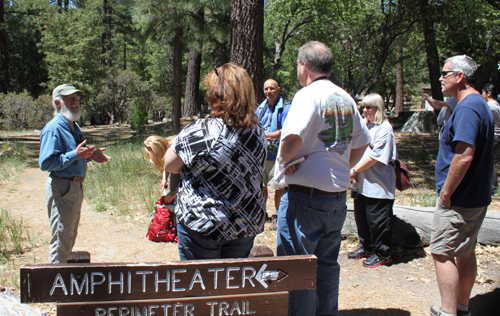
Of the three pine species — yellow, Jeffrey and ponderosa — in this forest, one can always tell the Jeffrey pine from its vanilla-like aroma.
The San Jacintos are part of the longest mountain range in North America, reaching as far as the tip of Baja, Mexico. Hamilton said the forests around this area were heavily milled from 1890 to 1950. Consequently, today’s pines are all new growth.
Besides towering pines, the Nature Center woods contain oaks and cedars. The black oak is deciduous and loses its leaves while the live oak remains evergreen. Pencils are made from the incense cedar.
Tree germination takes place through animal behavior. Squirrels put their cache of pine seeds in a tree and often do not return to eat them. Seeds can last 10 years in the soil before they germinate. Oaks and cedars probably will take over the pine tree forest in the future, said Hamilton.
The most fascinating part of the talk was ring growth or the lack of it on trees. Lately, due to climatic change, ring growth as been limited. Scientists compare tree rings and calibrate not only the year but the climate. Through this analysis the study of climate chronology goes back 10,000 years.
The Earth is experiencing more drought cycles. However, some trees have actually grown faster due to increased nitrogen exhaust from cars, Hamilton said. Nitrogen is a component of fertilizer.
With more drought comes fire. Hamilton emphasized fire as a part of the natural environment of the southwestern mountains due to lightning storms. Without fire, plants such as manzanita grow unusually tall and become more inflammable. The environment needs natural fires yet the issue is controversial in this area due to urbanization.
No talk is complete without the mention of earthquakes. The San Jacinto Mountains are on the Pacific Plate, which is moving rapidly and forms the tension with the North Atlantic Plate.
Lily Creek at the Nature Center is a riparian area which means it is home to 30 to 40 plants and animals whose lives are interdependent with the creek and the forest.
Hamilton is currently at the Blue Oak Ranch Reserve, University of California, Berkeley, and is formerly director of the James Reserve near Lake Fulmor. He has been personally acquainted with the San Jacinto Mountains since the 1970s.













